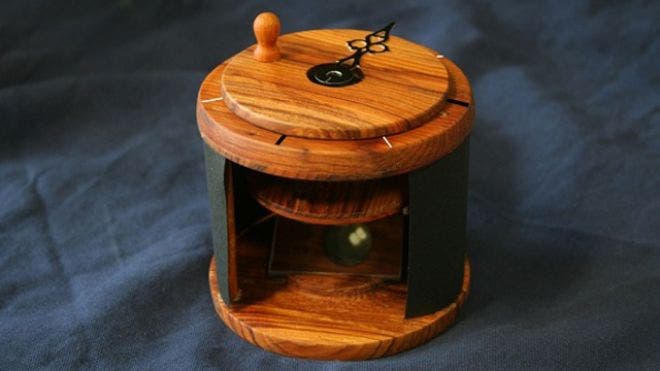
A Viking sunstone compass from a calcite crystal, used in the experimental setup by Rennes researchers. The two beams of light can be seen on the reflective surface inside. (c) Guy Ropars, University of Rennes
A very intriguing theory says that the Vikings used to navigate through traitorous Arctic waters, and possibly even through the Atlatic towards North America, by using a coveted mineral called the “sunstone“. These glowing, fabled stones used to guide the northsmen by revealing the position of the sun even when it was obscured by cloud or had sunk beneath the horizon. Now, scientists using an experimental setup with a similar crystal with the one found in a shipwreck have shown that such stones could indeed have helped the Vikings navigate from Norway to North America.
“The Vikings could have discovered this, simply by choosing a transparent crystal and looking through it through a small hole in a screen,” study researcher Guy Ropars said. “The understanding of the complete mechanism and the knowledge of the polarization of light is not necessary.”
It’s believed the Vikings used a common calcite crystal, called Icelandic spar. This stone has the special property that allows light to get polarized and broken into two – “ordinary” and “extraordinary” beams – when sunlight enters the crystal. Vikings might have calibrated calcite crystal sunstones by scanning them across a clear sky and noting the sun’s position when the crystal brightened. They could then repeat the trick to locate the sun when it was no longer visible by guiding themselves after the same reference point, subsequently marked.
RELATED: Viking boat burial found for the first time – archaeologists are thrilled
A team of researchers, led by Guy Ropars, at the University of Rennes in France, put the calcite crystal to the test. For their set-up, the scientists used icelandic spar found aboard a sunken Elizabethan military vessel, which was discovered in the 1970s by a fisherman off Alderney in the Channel Islands.
The sun compass
The Rennes researchers made a prototype sunstone compass themselves, after they covered the crystal with an opaque sheet that had a hole in the centre. The calcite worked particularly well (even with the naked eye), even when the sun was beyond the horizon and after the stars came out. Further tests showed that they could pinpoint the sun’s position with an accuracy of one degree in either directio
“Such sunstones could have helped the Vikings in their navigation from Norway to America, as the magnetic compass had yet to be introduced in Europe,” Guy said. A crystal measuring 3cm on each side would have been large enough to work, he added.
Onboard the Elizabethan vessel conventional magnetic compasses would’ve probably been prone to significant error, as even a single canon was enough to disrupt the magnetic field. The research confirms that the sunstone is more than a simply myth, and moroever that Vikings had the necessary navigation technology for a trip cross the Atlantic.









